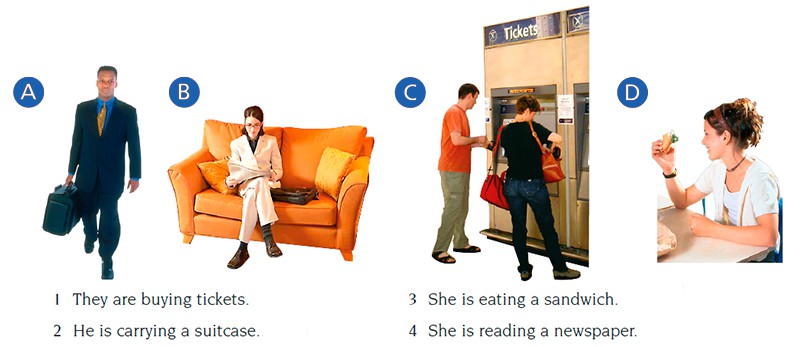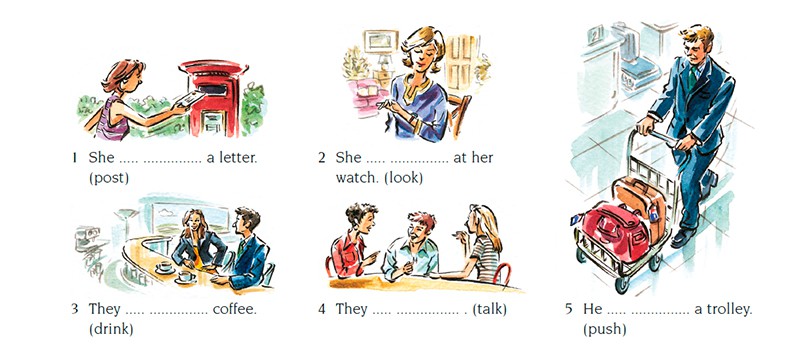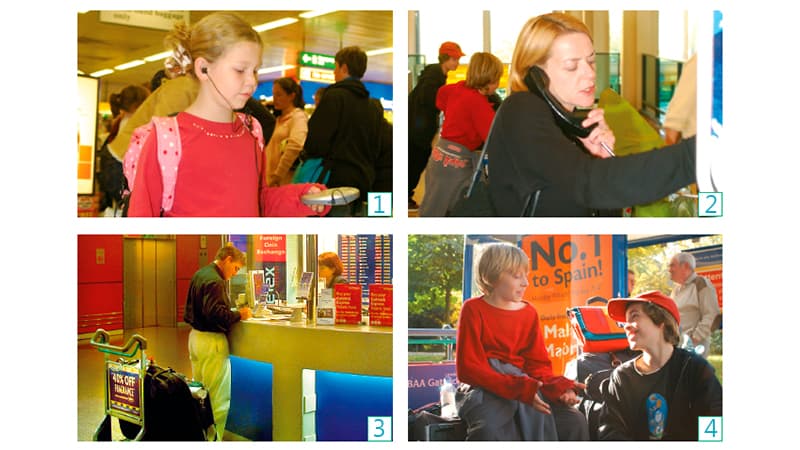O uso present continuous é muito comum a falantes de inglês. Por isso, é muito importante que estudantes dessa língua dominem essa forma verbal.
Nesta aula do nosso curso online de inglês, você aprenderá a utilizar o present continuous. Além disso, esta lição abordará o uso do plural.
1 . Observe as figuras abaixo. O que está acontecendo em cada uma delas? Relacione as figuras às frases.

Present Continuous
Usamos
este tempo verbal para descrever uma ação que está acontecendo no
momento em que se fala ou uma ação que já começou mas ainda não
terminou. O present continuous é formado pelo verbo auxiliar to be + o
verbo principal em sua forma -ing.
She is making a telephone call.
He is carrying a suitcase.
They are buying their tickets.
Existem algumas expressões de tempo que frequentemente usamos com o present continuous, como now e at the moment.
I am cooking dinner now.
He is reading the newspaper at the moment.
Construímos a forma negativa colocando not entre o verbo auxiliar to be e a forma -ing do verbo principal.
He is not carrying a suitcase.
They are not buying their tickets.
I am not cooking dinner now.
He is not reading the newspaper at the moment.
Construímos a forma interrogativa trocando a ordem do verbo auxiliar to be e do sujeito do verbo principal.
Is he carrying a suitcase?
Are they buying their tickets?
Is she eating her dinner?
Nota: Em inglês, verbos que denotam sentimentos não são usados na forma contínua. Exemplo: love, like, hate
I like him. ✓
I am liking him. ✗
Lembre-se! Para expressar rotinas, hábitos, situações permanentes e verdades absolutas, use o present simple.
I go to work by bus.
I live in Los Angeles.
I love swimming.
Para expressar uma ação que esteja ocorrendo agora, ou por um período curto de tempo, use o present continuous.
I’m waiting for the 93 bus.
2 . Observe as ilustrações e complete as frases usando o present continuous dos verbos entre parênteses.

Plurais
A maioria dos substantivos em inglês formam o plural pelo acréscimo de -s.
shop → shops
train → trains
cinema → cinemas
No caso de substantivos terminados em -ch, -sh, -s ou -x, acrescenta-se -es.
watch → watches
brush → brushes
bus → buses
box → boxes
Aos substantivos terminados em consoante + y, acrescenta-se -ies.
family → families
country → countries
Algumas exceções comuns são:
man → men
woman → women
child → children
person → people
Alguns substantivos não têm forma plural. São os substantivos que designam elementos não-contáveis. Alguns exemplos comuns são:
milk | water | bread
3 . Ouça quatro pessoas falarem no áudio. Identifique a qual imagem cada pessoa se refere e preencha o quadrado com seu respectivo número.

4 . Ouça novamente o áudio do exercício anterior. As pessoas costumam utilizar contrações. Você consegue identificá-las?
20 minutes+
Leia o texto abaixo. Anote em uma coluna os verbos que estão conjugados no present simple e em outra os verbos conjugados no present continuous.
My name is Helen Wilcox. I work for Eastern Airlines and I am a pilot. The company has 23 pilots, but only three are women. I love my job. The company is buying two new planes so, at the moment, I am learning to fly jumbo jets. It is difficult but I am working hard and, most importantly, I love it!
Word Bank
baggage (substantivo) = bagagem
book (substantivo) = livro
letter (substantivo) = carta
luggage (substantivo) = bagagem
read (verbo) = ler
sandwich (substantivo) = sanduíche
suitcase (substantivo) = mala
talk (verbo) = falar, conversar
trolley/cart (substantivo) = carrinho para bagagem
watch (substantivo) = relógio de pulso
Respostas:
Exercício 1
1-C; 2-A; 3-D; 4-B
Exercício 2
1) is posting
2) is looking
3) are drinking
4) are talking
5) is pushing
Exercício 3
1–Speaker 2
2–Speaker 1
3–Speaker 3
4–Speaker 4
Exercício 4
As contrações presentes no áudio são: I’m; she’s; they’re
20 minutes+
present simple
is
work
am
has
are
love
is
love
present continuous
buying
learning
working
 Sair da aula
Sair da aula